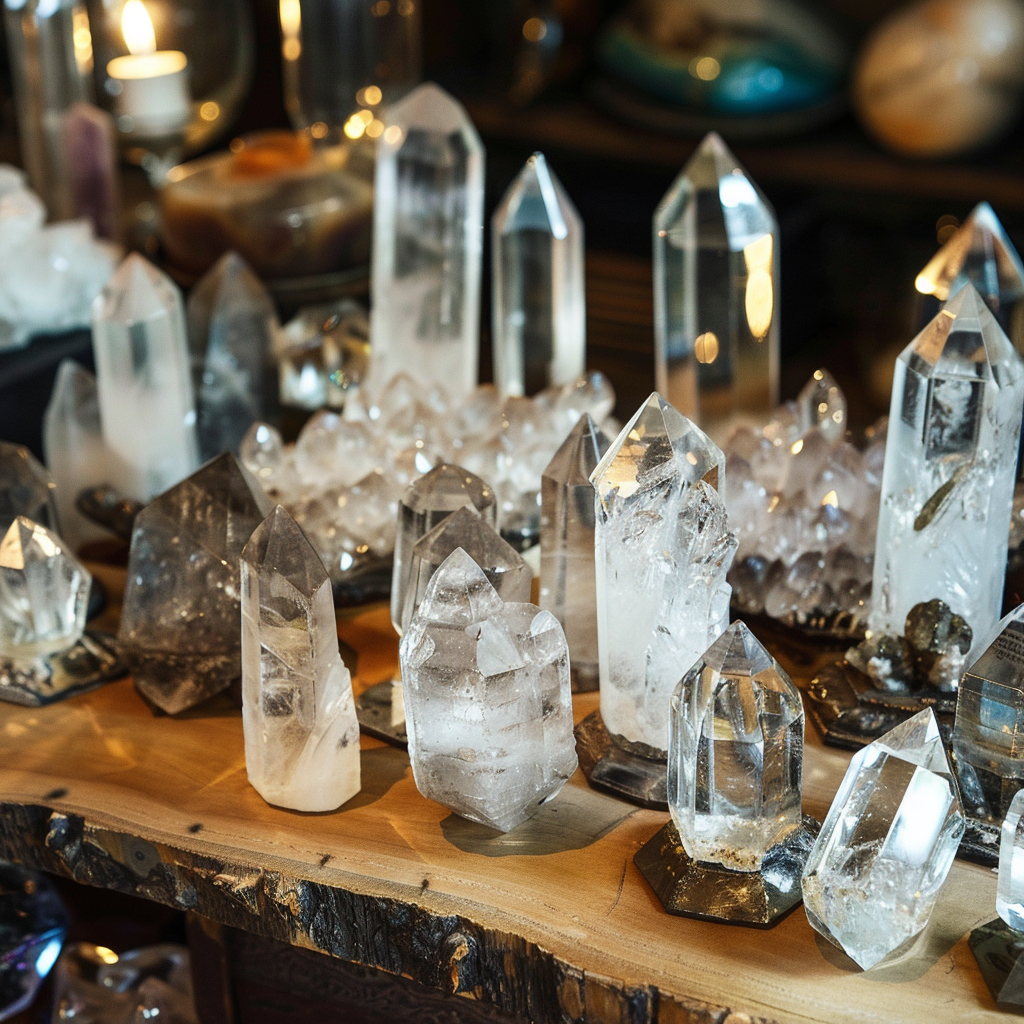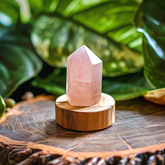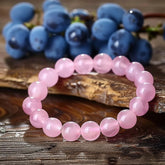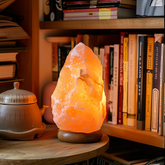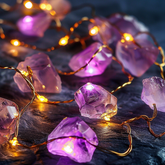How to Identify Crystals and Stones: Expert Guide
How to Identify Crystals and Stones: Expert Guide
Have you ever looked at a sparkling stone and wondered what it was and what powers it held? The world of crystals and gemstones is full of mysteries. Our guide will show you how to identify these stones, helping you to see their beauty and potential.

Identifying crystals is a mix of art and science. It involves looking closely at the stones and using scientific methods. Every day, new crystals are found, making this field exciting1. Knowing how to identify a stone is key to understanding its value, if it's real, and what it can do. With the right knowledge and tools, you can confidently identify crystals and stones, opening a world of wonder and discovery.
Crystals come in many colors, like the deep purple of amethyst and the golden shine of topaz2. We'll show you how to spot these unique features. From their colors and clarity to their structure and hardness, we'll guide you. Whether you're just starting or already love collecting stones, our tips will help you explore the world of crystal and stone identification.
Key Takeaways:
- Crystal identification combines visual inspection and scientific testing
- Color, shape, and hardness are crucial factors in identifying crystals
- Tools like jeweler's loupes and the Mohs scale aid in accurate identification
- Reference materials and guides are valuable resources for crystal enthusiasts
- Professional gemologists can provide expert assistance for complex identifications
Understanding the Basics of Crystal and Stone Identification
Crystal and stone identification is a blend of mineral analysis, rock classification, and mineralogical examination. It's a fascinating field that helps us learn about the world of minerals. We'll cover the key parts of this process to give you a strong base of knowledge.
The importance of accurate identification
Getting gemstones right is key. With practice, people can spot gemstones with 98% accuracy3. This accuracy is vital for knowing the gemstone's value, its realness, and how it's used. It matters in making jewelry and in scientific studies.
Common challenges in crystal recognition
There are many types of stones out there. For instance, Green Serpentine, Rose Quartz, and Smoky Quartz look different but are hard to tell apart for beginners4. Some stones look alike but are made of different stuff, so knowing what they're made of is key.
Building a foundation of knowledge
To get good at identifying crystals and stones, we need to know a lot. The Gemological Institute of America (GIA) has a special way to identify gemstones accurately3. They look at color, tone, and how bright it is using special scales. They use 31 colors and seven tone levels for colored stones3.
Knowing where gemstones come from helps too. Many come from places like Brazil, Peru, Mexico, India, and Madagascar5. This info helps narrow down what a stone might be when classifying rocks.
| Gemstone | Key Characteristics | Origin |
|---|---|---|
| Amethyst | Overall translucent purple coloring with hints of opaque quartz | Brazil |
| Labradorite | Overall even gray coloring with spots of colorful 'flash' at angles | Labrador, Canada |
| Pyrite | Sparkling golden brown coloring, known as 'fool's gold' | Peru |
By learning these basics and keeping up with new info, we can get better at identifying crystals and stones. This helps us do better in analyzing minerals and classifying rocks.
Physical Characteristics: Your First Clue
Identifying crystals and gemstones starts with their physical traits. We look at color, luster, transparency, and unique features like inclusions. These help us figure out what a crystal is.
Crystals have different lattice structures, like cubic or hexagonal. These shapes affect how they look and work. Knowing about these structures helps us identify crystals correctly.

Color is eye-catching but not always a sure way to identify minerals. Minerals can look the same but be different. Instead, we use streak, which is consistent within a mineral type6.
The Mohs Hardness Scale rates minerals from 1 (softest) to 10 (hardest). It shows how well a crystal resists scratches. This tells us about its makeup6.
Cleavage and fracture patterns are key in identifying crystals. Cleavage means a mineral breaks along certain planes. Fracture means breaks don't follow those planes6.
| Property | Description | Example |
|---|---|---|
| Color | Visual hue of the mineral | Varies widely |
| Streak | Color of mineral powder | Consistent for each mineral |
| Hardness | Resistance to scratching | Diamond (10 on Mohs scale) |
| Cleavage | Break along specific planes | Mica (perfect cleavage) |
| Fracture | Irregular breaks | Quartz (conchoidal fracture) |
Some minerals have special traits that help identify them. For example, Fluorite glows under certain lights, and Magnetite is magnetic6. These unique features give us the last clue in identifying crystals.
Color and Transparency: Visual Indicators
Color is key in crystal healing and appraising precious stones. We'll see how colors help identify different crystals and stones.
Understanding color variations in crystals
Crystals show a wide range of colors, each with special properties. The Gemological Institute of America (GIA) lists 31 colors for gemstones, aiding in their identification7. Some crystals have more than one color, and some may be treated to change their color.

Assessing transparency and opacity
Crystals differ in how clear they are, from very clear to completely opaque. Diamonds are very clear, amethysts are mostly translucent, and opals are opaque7. This is important for healing with crystals and appraising stones.
The role of inclusions in identification
Inclusions are natural flaws in crystals that make each one unique. Natural stones usually have inclusions, but synthetic ones might not8. Experts use magnifying tools to look at these features, like growth patterns and inclusions9.
| Crystal Type | Color Range | Transparency | Common Inclusions |
|---|---|---|---|
| Amethyst | Light to deep purple | Translucent to transparent | Color zoning, feathers |
| Rose Quartz | Pale to medium pink | Translucent | Rutile needles, clouds |
| Citrine | Pale yellow to brownish orange | Transparent to translucent | Liquid inclusions, phantoms |
Knowing about these visual signs helps us identify crystals well. It's key for healing with crystals and appraising stones. The mix of color, clarity, and inclusions makes each crystal unique, helping us learn about their benefits789.
Crystal Structures and Formations
For those who love geology, learning about crystal structures and formations is essential. Crystals form deep inside the Earth through different processes. They create unique patterns with molecules called lattices10.
These patterns repeat to make specific shapes and facets. These are key for identifying minerals. Almost all minerals are crystalline, starting from small seeds and growing in size10.

There are seven main types of crystal structures, each with its own lattice11:
- Tetragonal
- Cubic or Isometric
- Orthorhombic
- Hexagonal
- Trigonal
- Triclinic
- Monoclinic
Crystals can be grouped by their chemical and physical traits:
- Covalent Crystals (like diamond and zircon)
- Metallic Crystals (such as bismuth)
- Ionic Crystals (hard and have high melting points)
- Molecular Crystals (soft and melt easily, like sugar)11
The way a crystal forms affects its structure. Igneous minerals come from magma and are mostly silicates. Aqueous minerals form in water, and hydrothermal minerals come from warm waters. Metamorphic minerals change through solid reactions during metamorphism10.
| Crystal Type | Examples | Hardness (Mohs scale) |
|---|---|---|
| Covalent | Diamond | 10 |
| Metallic | Copper | 3 |
| Ionic | Fluorite | 4 |
| Molecular | Amber | 2 - 2.512 |
By exploring these structures and formations, we can see how amazing crystals are and their special properties.
How to Identify Crystals and Stones: Essential Techniques
In the world of lapidary arts and mineral analysis, knowing how to identify crystals and stones is key. We'll look at some important techniques used by experts. These methods help them figure out what different gemstones and minerals are.
Visual Inspection Methods
Looking closely at the color, clarity, and look of a crystal is the first step in identifying it. The gemstone industry, worth $1.55 billion in 2023, relies a lot on these visual traits for sorting13. Experts use tools like loupes and microscopes to spot tiny details that are hard to see by eye.

Hardness Testing Using the Mohs Scale
The Mohs scale of hardness is a key tool in mineral analysis. It ranges from 1 (softest) to 10 (hardest) and shows how well a crystal resists scratching. By testing the unknown crystal against known minerals, we can guess what it might be. For example, a diamond, being the hardest, is a 10 on the Mohs scale.
Specific Gravity and Density Measurements
Testing specific gravity is vital for telling apart gemstones that look alike. We use special gear to measure how dense a stone is compared to water. This is especially useful for rare gemstones like andalusite or painite, which are not common13.
| Technique | Equipment Used | Application |
|---|---|---|
| X-Ray Fluorescence (XRF) | XRF Analyzer | Rapid, nondestructive chemical analysis14 |
| Laser-Ablation ICP-MS | Mass Spectrometer | High-precision quantitative analysis14 |
| DiamondView | UV Imaging Device | Distinguishing natural from synthetic diamonds14 |
These methods are key to identifying gemstones professionally. While some people believe crystals have healing powers, with clear quartz and amethyst being seen as powerful, science is key for correct identification in lapidary arts15.
Tools and Equipment for Crystal Identification
In the world of gemstone recognition and mineralogical examination, having the right tools is key. We'll look at the essential equipment that experts use to identify crystals and stones with precision.

The 10x gem loupe is a must-have for any gemologist, costing about $21.95. It's crucial for looking at gemstones closely and spotting inclusions1617.
A refractometer, priced at around $99.99, measures a gemstone's refractive index. This helps narrow down options by looking at its optical properties. Polariscopes and dichroscopes are also key for checking if a gem shows single or double refraction1617.
For a closer look, microscopes are used. A professional gem microscope can be found for about $399.95. It's a big investment but great for serious fans and pros16.
Testing specific gravity is another important method. It involves weighing stones in air and water. You'll need precise scales (around $29.95) and special liquids. This method is safer than old, toxic ways like using Clerici solution1618.
Other useful tools include:
- Spectroscopes ($26.90) for analyzing absorption spectra
- Diamond testers ($105.95) for telling real diamonds from fakes
- Digital calipers ($36.05) for accurate measurements
These tools, along with knowledge and experience, are key to identifying gemstones correctly. For those eager to learn more about gemology, professional resources and guides offer great insights and techniques.
Gemstone Properties and Their Significance
Gemstones have been fascinating humans for over 5,000 years, used in both traditional medicine and spiritual practices19. In the world of precious stone appraisal and crystal identification, knowing about their properties is key.
Understanding Refractive Index
The refractive index shows how light changes when it goes through a gemstone. This is crucial for identifying crystals because each one has its own unique refractive index. For example, clear quartz, known as the "Master Healer," has a high refractive index. This helps it boost energies1915.
Assessing Luster and Fire
Luster is how light reflects off a gemstone's surface, and fire is about how it spreads light. These are important in appraising precious stones. Amethyst, with its protective qualities, has a shiny luster due to manganese19. Citrine, known for bringing success and wealth, shines brightly with its fire1915.

Recognizing Unique Optical Effects
Some gemstones have special optical effects that help identify them. For example, moonstone, linked to the moon, shows a unique sheen called adularescence19. Labradorite, tied to Gemini, has a stunning play of colors called labradorescence20.
| Gemstone | Property | Significance |
|---|---|---|
| Clear Quartz | High refractive index | Amplifies energy, protection |
| Amethyst | Vitreous luster | Inner strength, stress relief |
| Citrine | Brilliant fire | Success, wealth attraction |
| Moonstone | Adularescence | Fertility, harmony |
Learning about these properties helps us appreciate gemstones more and get better at identifying and valuing them. From black tourmaline's protective qualities to jasper's nurturing energy, each stone has its own special traits. These traits make them useful in both spiritual and everyday life1520.
Natural vs. Synthetic: Spotting the Differences
In the gemstone world, knowing the difference between natural and synthetic stones is key. The market is booming, with over $22 billion worth of gemstones sold in the U.S. alone. Most of these, about 85%, are either synthetic or lab-created21. This shows how vital it is to understand the differences between natural and man-made gems.
Natural gemstones take thousands or even millions of years to form. Synthetic ones are made in labs. A big difference is in their imperfections. Natural stones often have more inclusions and color variations. Lab-grown gems, on the other hand, have fewer flaws because they are grown in a controlled way21. This can help tell them apart during crystal identification.
Color uniformity is another way to spot the difference. Synthetic stones usually have more even colors. For example, most rubies and blue sapphires on the market have been treated to look better and have more color22. This treatment is less common in lab-created gems, which often have uniform color right away.
Weight can also help tell them apart, as some synthetic gems are denser than natural ones. But for sure identification, you usually need a pro. Gemologists use advanced tools like spectroscopy and refractometry for accurate identification.
| Characteristic | Natural Gemstones | Synthetic Gemstones |
|---|---|---|
| Formation | Over thousands/millions of years | Created in laboratories |
| Inclusions | More common | Less common |
| Color Uniformity | Often varied | Usually consistent |
| Price | Generally higher | 30-70% lower (varies by type)21 |
When buying something valuable, like a ruby, sapphire, or emerald over $1000, ask for a lab certificate22. Trusted labs like Gübelin, GRS, GIA, SSEF, and AIGS can give you expert certification. This ensures you know what you're buying and its true value.
Resources for Crystal and Stone Identification
We've put together a list of great resources for those who love geology and want to learn about minerals. These tools will help you figure out what crystals and stones you have with more confidence.
Reliable Reference Materials and Guides
A good crystal guide is a must-have. It lists 105 crystals, stones, and minerals, covering many types23. You'll find 12 healing stones, 7 for protection, and 13 spiritual stones23. For a deeper look, check out books on crystal structures and properties.
Online Databases and Apps
Online tools have changed how we identify crystals. Online databases give you fast access to lots of info. Mobile apps are also getting popular. The Stone Crystal Identification App has info on 69 crystals, and the Minerals Guide app has over 4000 crystals, their properties, and terms24.
These apps let you identify crystals by their color, hardness, and shine. Apps like Magic Of Crystal also teach about chakras and crystal uses24.
Professional Gemological Services
For the most precise identification, go for professional gemological services. They use special tools and know a lot to give you detailed info. Some services even have kits with over 60 samples of minerals and rocks25.
| Resource Type | Examples | Key Features |
|---|---|---|
| Reference Guides | Crystal Encyclopedia, Mineralogy Textbooks | Comprehensive information, detailed descriptions |
| Mobile Apps | Stone Crystal Identification, Minerals Guide | Quick reference, visual aids, portable |
| Professional Services | Gemological Laboratories, University Geology Departments | Expert analysis, specialized equipment, certification |
Using these resources together can improve your skills in identifying crystals. It will also deepen your knowledge of minerals and stones.
Conclusion
Learning how to identify crystals and stones is an exciting journey. It mixes science, observation, and hands-on learning. To spot a gemstone, you need a sharp eye and knowledge of its properties. Look for color changes, how clear it is, and special marks to figure out what it is and where it comes from2627.
Learning key skills like testing hardness and measuring specific gravity helps us spot different crystals and stones. Remember, finding out what a gemstone is can be tricky, especially with more fake stones and new treatments2728. That's why using the right tools, from simple magnifiers to advanced spectrometers, is key.
The world of gemology is always changing, which means identifying crystals can be tough. But, new tech and methods are coming out to help us tell real from fake gems. By keeping up, practicing, and getting help from experts when needed, we can master identifying crystals and stones28. Whether you collect gems, love jewelry, or want to be a gemologist, the skills you've learned here will help you in your journey.
FAQ
Why is accurate crystal and stone identification important?
Knowing what a crystal or stone is helps you understand its value and how it works. This is key for making jewelry, healing practices, and appraising gemstones.
What are some common challenges in crystal recognition?
There are so many types of stones, and some look very similar. Treatments or natural changes can also change their color, making it hard to tell them apart.
How can I build a strong foundation of knowledge for crystal identification?
Start by reading books on mineralogy and gemstones. Look at online databases and guides. Keep up with new discoveries in the field.
What are the key physical characteristics to observe during visual inspection?
Look at the color, shine, how clear it is, and any special features like inclusions. The shape of the crystal can also give away what it is.
How do I assess transparency and opacity in crystals?
It's important to see if a crystal lets light through or not. Some crystals are clear, while others are not.
What role do inclusions play in crystal identification?
Inclusions are special marks inside crystals that help tell them apart. Their patterns and colors can be clues to what kind of gemstone it is.
How can I identify different crystal structures and formations?
Crystals have different shapes based on how their atoms are arranged. Knowing these shapes is key to figuring out what a crystal is.
What are some essential techniques for identifying crystals and stones?
Look closely, test hardness with the Mohs scale, and check density. These methods are basic but very useful for identifying minerals and gemstones.
What tools and equipment are helpful for crystal identification?
You'll need a jeweler's loupe or magnifying glass, a refractometer, and sometimes special tools like spectroscopes or microscopes for a closer look.
How can I recognize unique optical effects in gemstones?
Pay attention to how light behaves with the gemstone, like its refractive index and luster. These can be clues to what the gemstone is.
How can I distinguish between natural and synthetic gemstones?
Natural stones usually have more inclusions and colors that vary more. Synthetic ones are often more uniform in color and can be heavier. Knowing these differences helps you tell them apart.
What resources can I use for crystal and stone identification?
Use gemstone guides, books on mineralogy, online databases, and apps. For expert help, look into professional gemological services that offer analysis and certification.
Source Links
- 8 Tips on How to Identify Stones and Crystals
- Simple Ways to Identify Crystals: 11 Steps (with Pictures)
- Gemstone Identification: How to Identify Gemstones
- Crystal Identification Chart - Identify Crystals & Stones
- Gem & Mineral Identification | Treasure Quest Mining
- Mineral Identification | Earth Science
- How to Identify Gemstones (with Pictures) - wikiHow
- How Can I Tell if the Gemstone I Have is Real? – Expert Tips
- Spot Real Gemstones Quickly How to Identify Gemstones
- 4 Crystals and Crystallization – Mineralogy
- Types of Crystal Structure and How Crystals are formed? Crystal and Mi
- Cave of the Mounds Educator Resources
- Gemstone
- Scientific Instruments Help Researchers Tell Gem Stories
- Everything You Need To Know About Healing Crystals and Their Benefits
- Recommended Gemology Tools and Instruments - Gem Society
- What tools does a gemmologist use to identify gemstones?
- Gemology tools
- Crystals & Their Meanings
- The A-Z of Gemstones meanings & star signs
- Can You Tell the Difference Between Lab Created or Natural Gemstones
- Real Gemstones Or Fakes? How To Tell The Difference
- Crystal Encyclopedia Index - Crystal Vaults
- Crystal Identification: Best Identifier Apps, Stone Color Charts and Guides
- Rock Identification Guide
- An Introduction to Gemstone Inclusions - International Gem Society
- How to Identify Authentic Crystals — Crystal Meanings
- Beginner’s Guide: Everyday Gemstone Identification In The Field | Gem-A


